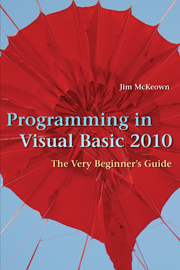Book contents
- Frontmatter
- Contents
- Preface
- 1 Fundamentals of Design and Programming – Starting from Scratch
- 2 Variables and Constants – A Place for Everything and Everything in Its Place
- 3 Writing Programs – First You Walk, Then You Run
- 4 Writing Programs II – More Controls and New Logic
- 5 Using If and Case – Decisions, Decisions, Decisions
- 6 Loops – Once Is Not Enough
- 7 Procedures and Functions – Divide and Conquer
- 8 Writing Programs III – Tying It All Together, So Far
- 9 File I/O – Files and Records and Fields, Oh My!
- 10 Arrays and Structures – Organizing Data
- 11 Events and More Controls – Tips and Tricks for Programming
- 12 Objects and Classes – Objects Are in a Class By Themselves
- 13 Graphics – The Visual (and Audio) Side of Visual Basic
- 14 LINQ to SQL – The World Runs on Databases
- 15 Crystal Reports – Tying Databases to Output
- Appendices
- Index
10 - Arrays and Structures – Organizing Data
Published online by Cambridge University Press: 05 June 2012
- Frontmatter
- Contents
- Preface
- 1 Fundamentals of Design and Programming – Starting from Scratch
- 2 Variables and Constants – A Place for Everything and Everything in Its Place
- 3 Writing Programs – First You Walk, Then You Run
- 4 Writing Programs II – More Controls and New Logic
- 5 Using If and Case – Decisions, Decisions, Decisions
- 6 Loops – Once Is Not Enough
- 7 Procedures and Functions – Divide and Conquer
- 8 Writing Programs III – Tying It All Together, So Far
- 9 File I/O – Files and Records and Fields, Oh My!
- 10 Arrays and Structures – Organizing Data
- 11 Events and More Controls – Tips and Tricks for Programming
- 12 Objects and Classes – Objects Are in a Class By Themselves
- 13 Graphics – The Visual (and Audio) Side of Visual Basic
- 14 LINQ to SQL – The World Runs on Databases
- 15 Crystal Reports – Tying Databases to Output
- Appendices
- Index
Summary
VB Quip
[By the end of the 20th Century there will be a generation] to whom it will not be injurious to read a dozen quire of newspapers daily, to be constantly called to the telephone [and] to live half their time in a railway carriage or in a flying machine.
– Max Nordau in 1895So far you have seen how a sequence of steps lets you build a program that will do your bidding. You've seen how decision structures give the computer the ability to make decisions. You've learned how to get the computer to repeat instructions, giving it the ability to do the same task over and over. And, you've taught it how to read and write. Well, it can't read and write, but it can access and store data in a file. All of these give the computer the ability to access and process data at remarkable speed. But, you've been limited to only a handful of names and numbers – only what you could hold in your hand and keep track of in your head. You've been forced to discard one thing in order to grab the next. It's as if the world was a full-screen movie and you're stuck looking at stills in the family photo album. Enter arrays. With an array you can grab an armful of data and process it as you wish. Instead of stills on Grandma's porch, you've got a DVD on HD and control of the remote.
- Type
- Chapter
- Information
- Programming in Visual Basic 2010The Very Beginner's Guide, pp. 367 - 428Publisher: Cambridge University PressPrint publication year: 2010



